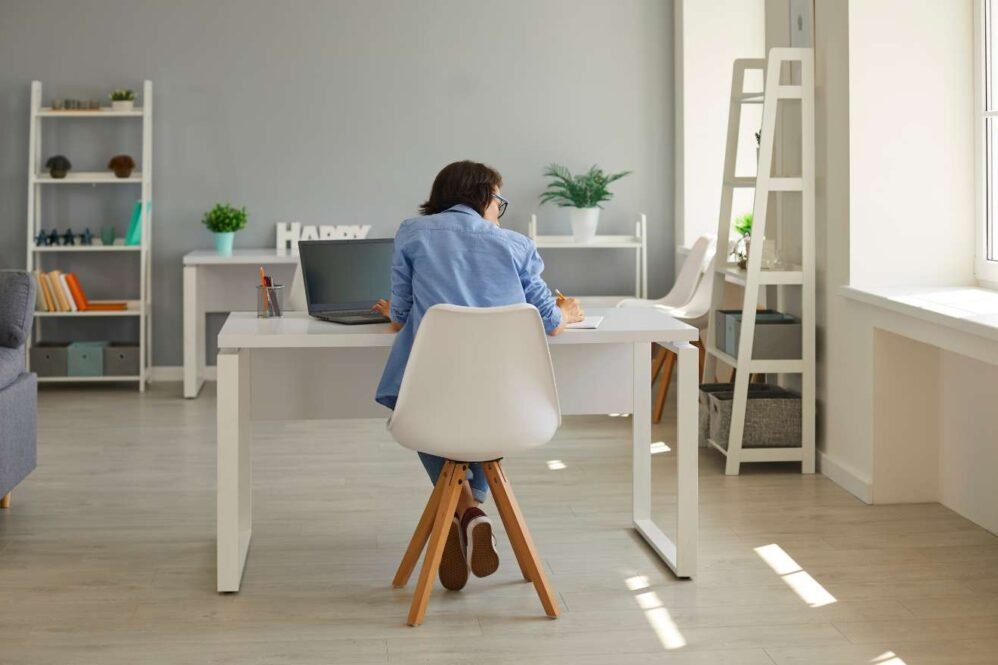Table of Contents
Reduce Paper Usage in Home Office
Going paperless is one of the best ways to make your home office more sustainable. Start by switching as many tasks and workflows to digital as possible. For tasks that still require printing, be sure to enable duplex printing in your printer settings. This allows you to print on both sides of the paper, reducing your paper usage by up to 50%.
Get in the habit of reusing scrap paper for notes and draft prints. Use the blank sides before grabbing a fresh sheet. And be diligent about recycling all your paper waste. Set up bins for recyclables next to your printer and shredder to make it easy. Recycle envelopes, junk mail, magazines, newspapers, and any other clean paper products. Just be sure to remove any plastic, metal, or other contaminants first.
With some simple habit changes, you can dramatically cut the amount of paper used in your home office. This saves trees while also reducing waste and your environmental footprint. Going paperless improves organization and productivity too. So it’s a green win-win for your freelance business and the planet.
Energy-Efficient Equipment for Home Office
When it comes to office equipment, look for electronics that are EnergyStar-certified. This means they meet strict energy efficiency guidelines set by the EPA. Some easy ways to go green with your electronics:
- Choose a laptop over a desktop computer. Laptops consume far less energy than desktops, especially when running on battery power. They also take up less physical space.
- When buying a new computer, look for the EnergyStar logo. The certification means the device has power-saving features enabled out of the box.
- Enable sleep settings on computers, monitors, and other devices so they power down when inactive. EnergyStar products enter low-power mode quickly.
- Replace outdated equipment like printers and monitors with EnergyStar models. The program adds new certified products every year with increased efficiency.
- Unplug devices when not in use to eliminate phantom load. Consider getting a power strip to turn off multiple electronics at once.
- If you need a lot of computing power, build an energy-efficient desktop with components like low-wattage processors, SSD storage, and efficient power supplies. Avoid low-end power supplies which waste a lot of electricity.
Going EnergyStar helps cut electric bills while also reducing your carbon footprint. With efficient modern hardware and conscientious usage habits, your home office can stay green.
Smart Lighting for Home Office
Lighting can account for up to 20% of your home energy usage, so making smart lighting choices is an impactful way to green your home office. Taking advantage of natural sunlight during the day and replacing traditional bulbs with more efficient LEDs can significantly reduce your energy consumption.
Installing lights and lamps near windows and skylights helps you capitalize on free, abundant daylight. Position your desk near windows facing north or south to avoid glare on your screens. Use sheer curtains or blinds to diffuse direct sun when needed. Turn off overhead lights when ambient light is sufficient.

Swap out incandescent and CFL bulbs for EnergyStar-rated LEDs, which use at least 75% less energy and last 25 times longer. The long lifespan also saves on replacement costs. Choose LEDs with a color temperature between 2700K-3000K to reduce eye strain.
Install smart lighting controls like occupancy sensors, timers, and dimmers. Motion sensors automatically turn lights on when you enter a room and off after a set time. Timers allow you to program lights to turn on/off at set times. Dimmers give you flexible control over brightness. Strategic use of lighting controls prevents energy waste from lights left on accidentally.
Green Cleaning Supplies for Home Office
Transitioning to green cleaning supplies is an easy way to make your home office more eco-friendly. Conventional cleaning products often contain harsh chemicals like ammonia, bleach, and formaldehyde that can be harmful to your health and the environment.
Opting for non-toxic cleaners is better for indoor air quality. Look for plant-based ingredients like vinegar, baking soda, lemon juice, and essential oils. Microfiber cloths are also great sustainable swaps – they can be washed and reused hundreds of times, reducing waste. Ditch paper towels for reusable rags made of old t-shirts and towels.
With some simple swaps to natural cleaning solutions and reusable products, you can keep your home office clean while reducing plastic waste and exposure to toxic chemicals. Your health and the planet will thank you!
Reduce Water Waste in the Home Office
When working from home, it’s easy to let the water run freely without thinking about conservation. However, there are some simple ways to reduce your water usage and waste in your home office.
One of the best ways is to install low-flow faucets and showerheads. These fixtures restrict the flow of water to around 1.5 or 2 gallons per minute, compared to standard models which use 2.5 gallons per minute or more. Low-flow fixtures provide the same water pressure while using a fraction of the water.
You can also take shorter showers to reduce water waste. Limit your showers to 5 minutes or less. Turn off the water when lathering up or shaving to save even more. Little changes like this can make a surprising difference in your overall water usage.
Try not to let faucets run while brushing teeth, washing hands, or doing dishes. Only use what you need. Be mindful not to let the hose run when watering plants. And fix any leaks right away – a small drip can waste hundreds of gallons over time.
With some simple adjustments, you can significantly cut back on the amount of water you use in your home office. This saves precious resources and money on your utility bills. Going green doesn’t require major sacrifices, just a little mindfulness.
Reusable Supplies for Home Office
Using reusable supplies in your home office is an easy way to reduce waste and have a more eco-friendly workspace. Investing in quality products that can be used over and over, rather than disposable items, saves money in the long run too.
- Refillable pens and markers: Look for good quality pens and markers that allow you to replace the ink cartridge or refill when empty. Companies like Pilot, Pentel, and Staedtler offer refillable marker and pen options. This cuts down on plastic waste from an endless stream of disposable writing instruments.
- Reusable notebooks: Opt for bound notebooks with reusable pages rather than spiral notebooks or notepads. You can purchase a high-quality notebook like a Moleskine and use it for years, just archiving older pages. This eliminates constantly having to buy new notepads. Some notebooks even allow you to refill pages when needed.
- Glassware and mugs: Keep reusable glassware on hand for beverages instead of using disposable cups or mugs. A set of sturdy drinking glasses and a thermal mug for hot drinks create less waste while keeping drinks cold or hot. You can find great reusable glassware and mugs from brands like Hydro Flask, YETI, and Ello.
Choosing reusable supplies made with eco-conscious materials gives your home office an earth-friendly makeover. With some smart swaps, you can have quality products that last while avoiding unnecessary waste.
Sustainable Furniture for Home Office
When setting up your home office, look for furniture made from recycled, upcycled, or sustainably sourced materials. Many stylish and affordable options are there that don’t compromise on comfort or quality.
Upcycled furniture gives new life to materials that would otherwise go to waste. Old doors and pallets can be made into desks, while vintage items like suitcases or crates can become shelves. Not only is this an environmentally-friendly choice, but upcycled pieces add character to your space.
For new furniture, look for brands that use recycled materials like steel, reclaimed wood, and even recycled plastic bottles. Sourcing lumber from responsibly-managed forests is also an eco-friendly option. Bamboo is a renewable grass that makes great furniture too.
The key is to read labels and product descriptions carefully. Many retailers now specify if items are made from recycled, upcycled, or sustainably sourced materials. Investing in high-quality, environmentally-conscious furniture means it will last for years to come.
Renewable Energy for Home Office
Transitioning to renewable energy sources like solar or wind power is one of the most impactful steps you can take to green your home office. Installing solar panels on your roof harnesses energy from the sun to power your home office equipment and appliances. This reduces your reliance on fossil fuel-based electricity from the grid.
Beyond rooftop solar, check if your local energy provider offers plans to source renewable energy from solar farms or wind turbines. Many energy companies now give customers the option to pay a small premium on their bill to get some or all of their electricity from clean energy sources. This allows you to support the growth of renewables even if you rent or can’t install solar panels yourself.
Some key benefits of switching to renewable energy:
- Reduces your carbon footprint. Solar and wind power emit little to no greenhouse gases.
- Locks in consistent energy rates. The fuel costs for renewables like sunlight and wind are free! This shields you from fluctuating fossil fuel prices.
- Supports the green economy. Choosing renewable power creates market demand and jobs in the solar, wind, and other cleantech industries.
- Provides energy security. Producing your power locally with solar panels gives you energy independence and reduces grid reliance.
- Saves money long-term. While solar panel installation costs are high initially, your electric bills will drop dramatically. Most solar financing plans let you leverage tax credits and start saving right away.
With renewable energy costs dropping fast, now is the time to join the clean power movement. A solar or wind-powered home office helps demonstrate your commitment to sustainability.
Eco-Friendly Shipping in Home Office
When running an eco-friendly home office, it’s important to also consider the environmental impact of how you ship orders and packages. There are several sustainable shipping practices you can implement:
- Use reusable packaging materials as much as possible. Look for shipping boxes, envelopes, and mailers that are designed to be used multiple times. Reusable packaging greatly reduces waste since you don’t have to keep purchasing new materials.
- Opt for biodegradable mailers and padding. If you do need disposable packaging, choose materials made from natural and renewable resources like paper, cotton, cornstarch, etc. These will break down safely when disposed of. Avoid plastic padding like bubble wrap or foam peanuts.
- Eliminate excess packaging materials. Only use as much padding as needed to safely ship an item. Overpacking with styrofoam or bubble wrap is wasteful.
- Look into eco-friendly couriers. Research delivery services that offer carbon-neutral shipping or other sustainability initiatives. This helps offset the environmental impact of transporting packages.
- Bundle orders together. If you have multiple orders going to the same area, try packing them together in one reusable box. This optimizes each delivery trip.
- Provide return shipping labels. Making it easy for customers to return packaging prevents additional materials from being used back and forth.
With some creativity and research, you can find ways to make your fulfillment operations much more eco-friendly. It’s a great way to further reduce the carbon footprint of your home business.
Offset Carbon Footprint in Home Office
As a green freelancer working from home, it’s important to take responsibility for your carbon footprint from business activities like shipping orders and online tools that use electricity. One great way to counteract these greenhouse gas emissions is by purchasing verified carbon offsets. These fund projects like tree planting that actively remove CO2 from the atmosphere.
Look for offsets from reputable sources that follow established standards to ensure the reductions are real. Aim to offset at least the estimated emissions from your freelance business operations. Going above and beyond by offsetting personal emissions too makes an even bigger positive impact. With affordable offsets available, any freelancer can easily achieve carbon neutrality.

Planting trees yourself is another simple, satisfying way to cancel out your carbon footprint. Trees absorb CO2 as they grow, so maintaining a small urban orchard can balance out your work emissions. Fruit trees provide the added benefit of local food production. If you have the space, planting even more trees through a nonprofit initiative multiplies your positive effect.
Taking personal responsibility to offset freelance emissions provides ecological benefits far beyond your home office. Supporting legitimate offset programs and tree planting campaigns creates real change in fighting climate change.









